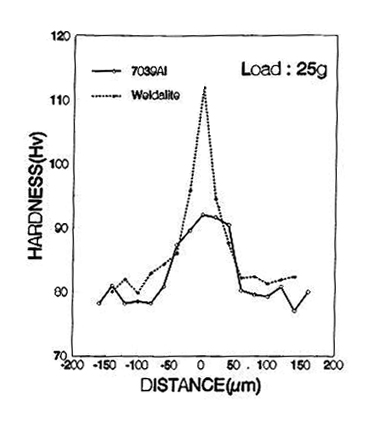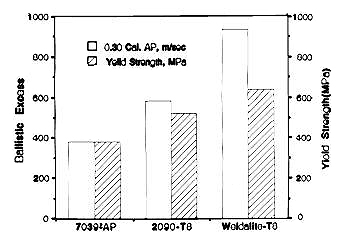Ballistic Protection Efficiency of Aluminum Alloys
Abstract
This study examines the ballistic protection capabilities of aluminum alloys, focusing on their effectiveness against high-velocity projectiles and armor-piercing ammunition. Aluminum alloys offer superior strength-to-weight ratios, making them ideal for military applications where mobility and protection are critical. The research investigates Al-Li alloys, specifically 2090 Al-Li and WELDALITE 049, comparing their performance with conventional 7039 Al alloy through dynamic torsional testing and ballistic impact analysis. Results demonstrate that aluminum alloy composite armor systems can provide twice the ballistic protection of homogeneous steel armor without weight penalties. The formation of adiabatic shear bands and delamination mechanisms significantly influences ballistic performance, with Al-Li alloys showing superior energy absorption characteristics through intergranular crack propagation rather than traditional shear band formation.
Introduction to Aluminum Alloy Ballistic Protection
Modern military forces require an optimal balance between firepower, mobility, and ballistic protection to maintain combat readiness. This fundamental requirement drives the continuous development of advanced armor materials that can provide maximum protection while minimizing weight penalties. Aluminum alloys have emerged as critical materials in this endeavor, offering exceptional ballistic protection efficiency against high-velocity projectiles and armor-piercing ammunition.
The effectiveness of ballistic protection systems relies on the strategic combination of extremely hard metallic and non-metallic materials. Composite armoring solutions typically employ two-layered and multi-layered configurations incorporating aluminum, steel, titanium, ceramics, epoxy/glass composites, and various resin systems. These sophisticated material combinations maximize energy absorption while maintaining structural integrity under extreme impact conditions.
Aluminum Alloys in Military Applications
Aluminum alloys have established a dominant position in military armor development due to their exceptional availability, machinability, and cost-effectiveness. The strength-to-weight ratio, plasticity, fracture toughness, and corrosion resistance of aluminum alloys make them indispensable in modern military applications. Advanced manufacturing technologies have enabled the replacement of traditional steel components with aluminum alloy alternatives in fighting vehicles, missiles, ammunition systems, fighter aircraft, naval vessels, and portable military infrastructure.
The pursuit of high mobility in modern warfare has further emphasized the importance of aluminum alloys in reducing equipment weight without compromising protection levels. Aluminum armor plating primarily protects military vehicles against rifle ammunition and artillery projectile fragments, replacing steel armor systems with hardness ratings of 320-380 HB that were standard before 1960.
Advanced Al-Li Alloys for Ballistic Protection
Aluminum-lithium alloys represent the next generation of ballistic protection materials, offering high strength, exceptional stiffness, and reduced weight characteristics that provide tremendous potential as structural armor materials. However, limited research exists regarding the dynamic properties of Al-Li alloys, despite the known correlation between ballistic performance and dynamic deformation behavior, particularly concerning adiabatic shear band formation.
Understanding Adiabatic Shear Band Formation
Adiabatic shear bands constitute narrow regions of highly localized plastic deformation commonly observed when materials experience high strain rate deformation during ballistic impact, machining, and high-speed metal forming processes. These phenomena result from thermomechanical plastic instability development. Since localization typically induces structural component failure through reduced load-carrying capacity within the shear band, understanding adiabatic shear banding becomes crucial for optimizing ballistic performance.
Research efforts focus on correlating adiabatic shear band development in Al-Li alloys during ballistic impact with dynamic deformation behavior investigated through dynamic torsional testing. This correlation provides enhanced understanding of adiabatic shear band origins in Al-Li alloys and their relationship to overall ballistic performance.
Experimental Analysis of Al-Li Alloy Performance
Material Selection and Testing Methodology
The investigation examined 2090 Al-Li alloy and WELDALITE 049 alloy to enable comparative analysis of different strength levels and microstructural characteristics. These Al-Li alloys were compared against 7039 Al alloy, which serves as an established armor material benchmark. The dynamic strain rate applied during testing reached approximately 10³ s⁻¹ in shear, with dynamic shear stress-strain curves obtained through dynamic torsional testing.
Microstructural elements including grain boundaries, precipitates, and inclusions were considered critical factors in shear band formation throughout the investigation. Dynamic torsional deformation of ductile metallic materials typically develops through three distinct stages: homogeneous deformation before maximum shear stress, inhomogeneous deformation beginning at maximum shear stress, and adiabatic shear band initiation and development due to localized shear deformation.


Figure 1: Behavior of Al-Li alloys during ballistic impact and dynamic torsional testing
Key Experimental Findings
The experimental results revealed significant insights into Al-Li alloy ballistic performance characteristics. The 2090 alloy and Weldalite alloy demonstrated superior performance with minimal adiabatic shear band formation even near perforated regions, while shear bands formed more readily in the 7039 alloy. The front surface of impacted areas showed extensive thin delaminated sheets in the 2090 alloy and substantial fragmentation in the Weldalite alloy.
Microscopic examination of Weldalite alloy shear bands revealed minimal adiabatic shear band formation in limited areas with extremely narrow widths. These observations aligned with dynamic torsional test results, confirming that the Weldalite alloy exhibited the highest maximum shear stress values among tested materials.
The 2090 alloy, characterized by heavily elongated grains and coarse grain boundary particles, displayed numerous intergranular cracks near perforated regions and central areas of dynamic torsional specimens. These intergranular cracks provided beneficial effects on ballistic performance by preventing adiabatic shear band formation and promoting elongated grain delamination.
Ballistic Testing Methods and Standards
Evolution of Testing Methodologies
Ballistic protection testing methodology has evolved alongside the development of various impacting projectiles and armoring materials to design the most effective protection systems. Modern sophisticated weapons require comprehensive ballistic testing of armoring materials to quantify meaningful protective quality measures against high kinetic energy projectiles.
Before selecting specific armoring materials or material combinations for required protection levels, ballistic tests must determine armor capability to impede or defeat incoming projectiles. Armor systems must withstand the same projectile attacks anticipated in hostile environments. Research laboratory testing typically involves impacting single targets with single projectiles launched from guns or specialized weapons, providing ranking systems for different armoring materials based on weight, areal density, or thickness parameters.
Armor Efficiency Evaluation Criteria
Reliable armor efficiency evaluation requires controlled ballistic tests following standardized procedures. Ballistic testing involving single target impact by single projectiles evaluates armoring material resistance to penetration and perforation. Complete penetration occurs when projectile or armor fragments are ejected from the armor's back surface with sufficient energy to pierce a 0.50 mm aluminum alloy witness plate positioned behind the target.
Impacts that rebound from armor plates, remain embedded in targets, or pass through targets without sufficient energy to pierce aluminum witness plates are classified as partial penetration. The most frequently applied criterion for evaluating ballistic performance is the V₅₀ concept, based on ballistic limit definitions.
Performance Rating Systems
Ballistic efficiency comparison between different armors against specified kinetic energy projectiles utilizes velocity merit ratings (V₅₀) or weight merit ratings. Weight merit rating represents the ratio of reference armoring material areal density (typically homogeneous armor steel) to experimental armor areal density, representing mass effectiveness (Em) of the armor system.
Ceramic materials applied as additional ballistic protection on aluminum or steel armoring plates result in composite armor systems with inevitably lower mass effectiveness compared to ceramic-only systems due to reduced metallic armor backing effectiveness. Nevertheless, Em values for composite ceramics/aluminum alloy armor can exceed twice the Em values of composite ceramics/steel armor systems. This performance advantage demonstrates that ceramic integration offers double the ballistic protection compared to homogeneous steel armor without weight increases.
Energy Absorption Mechanisms in Ballistic Protection
Impact Energy Distribution
When target materials experience ballistic impact, impact energy absorption and distribution occur through plastic deformation, fragmentation, crack propagation, material melting, and vaporization processes. Ballistic performance depends on the effectiveness of impact energy absorption through these mechanisms.
Common methods for measuring energy absorption during deformation and fracture include tensile, compressive, or torsional testing, as well as Charpy impact testing. While Charpy impact tests offer simplicity and economic advantages, results may contain significant errors inherent to the test method. Conventional testing methods provide accurate stress state interpretation with minimal experimental errors but cannot effectively evaluate ballistic performance due to inability to reach strain rates comparable to actual ballistic impact situations (10⁵ to 10⁶ s⁻¹).
Dynamic Torsional Testing Advantages
Dynamic torsional testing using torsional Kolsky bars eliminates cross-sectional area changes caused by Poisson effects, facilitating stress state analysis during deformation processes. Since plastic deformation energy requirements are provided by projectile kinetic energy, ballistic performance depends on the extent to which plastic deformation can absorb kinetic energy.
The kinetic energy absorption capability of target materials directly correlates with their ability to undergo extensive plastic deformation before failure. This relationship explains why materials with superior ductility and energy absorption characteristics, such as aluminum alloys, demonstrate enhanced ballistic protection performance compared to brittle alternatives.
Conclusion
Aluminum alloys, particularly advanced Al-Li systems, represent superior ballistic protection solutions for modern military applications. The combination of exceptional strength-to-weight ratios, energy absorption capabilities, and manufacturing advantages positions aluminum alloys as critical materials for next-generation armor systems. Understanding the complex relationships between microstructural characteristics, deformation mechanisms, and ballistic performance enables the development of optimized protection systems that meet demanding military requirements while maintaining mobility advantages.
Access Precise Properties of Aluminum Alloys Now!
Total Materia Horizon contains property information for 30,000+ alumiums: composition, mechanical, physical and electrical properties, nonlinear properties and much more.

Get a FREE test account at Total Materia Horizon and join a community of over 500,000 users from more than 120 countries.